Here?s an Easy Biohack that May Lower Your Sleeping Heart Rate by Ten Beats Per Minute
 What governs heart rate during sleep? Photo credit: Vladislav Muslakov
What governs heart rate during sleep? Photo credit: Vladislav Muslakov
Wearables have made heart rate and sleep tracking easy and popular ? but how to best make sense of the data?
While mere mortals have a resting heart rate (RHR) of 60 to 80 beats per minute (bpm), world class athletes like sprinter Usain Bolt and Tour De France cyclist Miguel Indurain purportedly thrive at with a RHR around 30 bpm when in peak condition. A prospective study of over 20,000 people in Finland demonstrated that lower resting heart rates are associated with lower cardiovascular mortality, 2?3-fold lower for a RHR of <60 bpm versus >90 bpm. It seems simply that lower resting heart rates are better.
A few months ago, I started wearing an Oura ring and looking at my overnight data. The ring did a good job of recording my time going to sleep, getting up, and overnight waking. My vivid dreams were associated with rapid eye movement (REM) sleep. My periods of deep sleep occurred earlier in the night. So far, so good.
As I tracked my fitness, it occurred to me that looking at the heart rate over a full night of sleep could give me more data than just a snapshot RHR during the day (usually around 60?64 bpm). A 2003 paper in the Journal of Sports Science and Medicine had begun to investigate just this idea but found high night-to-night variability (about 8 bpm in minimum heart rate) even with no changes in exercise regime. The various wearable manufacturers usually discuss sleeping heart rate as one measure of daily ?readiness? or ?sleep quality? rather than fitness (Oura, Apple, Fitbit, Polar).
Upon digging into the data, I found that at least in my case both the fitness and readiness concepts were misleading as the big driver of my overnight heart rate was actually daily calories.
On typical days with three regular meals including a large dinner, my overnight mean and minimum heart rate was generally in the 60s.
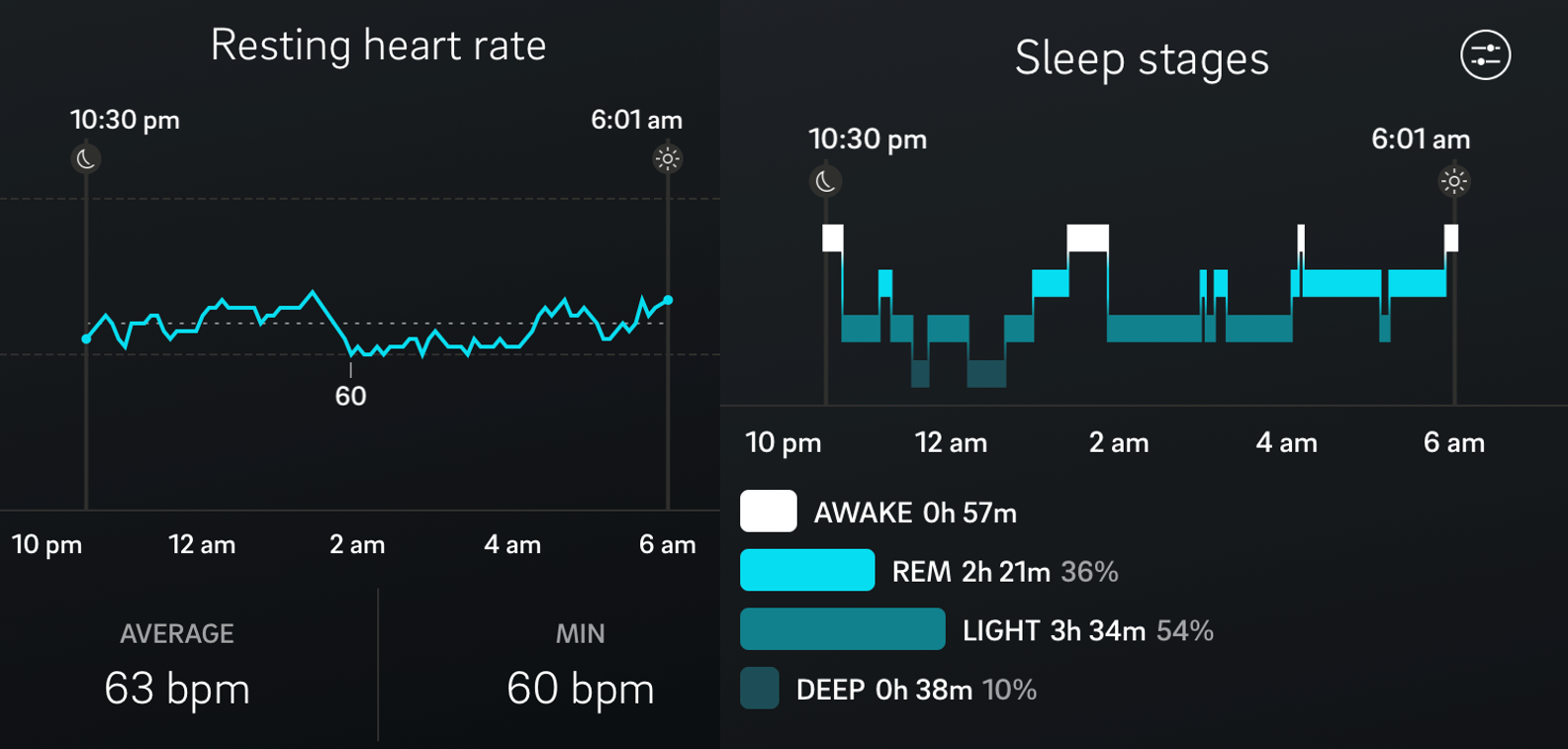 Resting heart rate and sleep stages by Oura ring with 2,500 kcals.
Resting heart rate and sleep stages by Oura ring with 2,500 kcals.
On days with fewer calories, such as time-restricted eating including skipping dinner, my overnight mean and minimum heart rate was generally in the 50s.
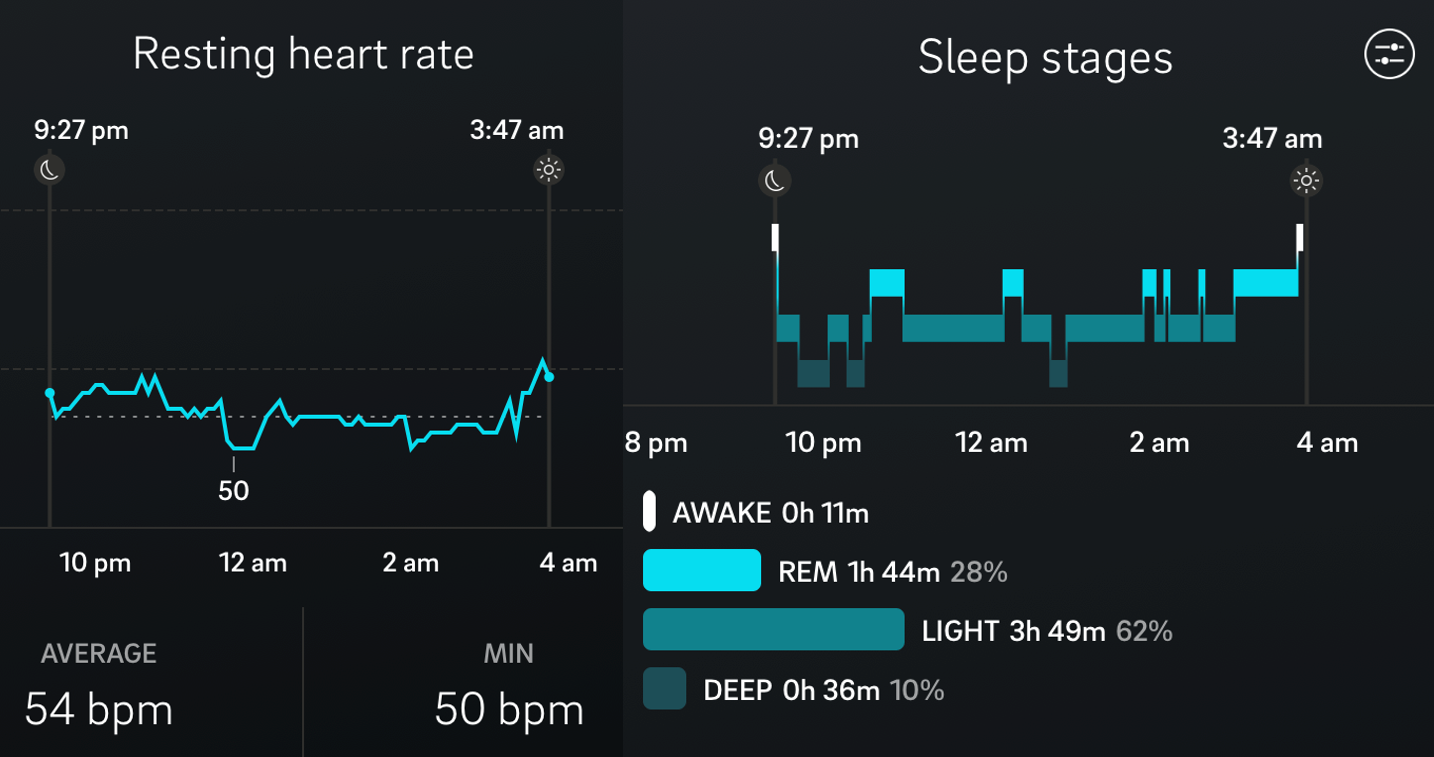 Resting heart rate and sleep stages by Oura ring with 250 kcals.
Resting heart rate and sleep stages by Oura ring with 250 kcals.
To explore this further, I tracked calories for three weeks and the trend held. By linear regression, daily total calories correlated with mean overnight heart rate (R-squared= 0.45). The relationship was statistically significant (F-statistic = 16.34, P-value of the F-statistic = 0.00064). Calories at dinner rather than totally daily calories showed the same relationship with overnight heart rate (R-squared= 0.42).
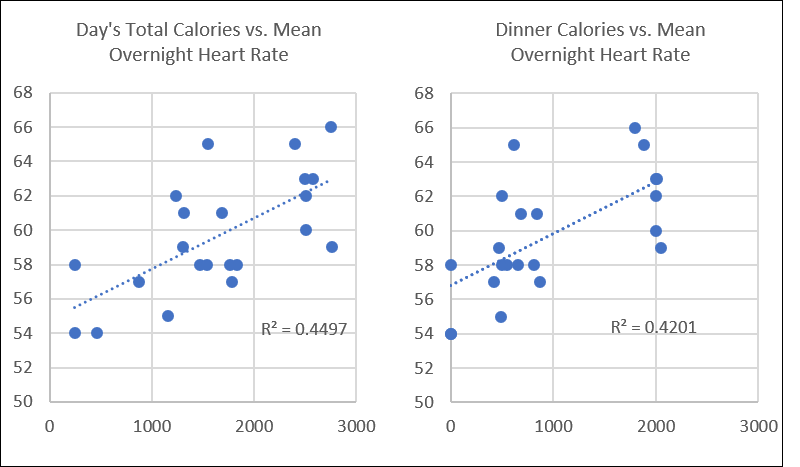 Time-restricted feeding (such as skipping dinner) lowers mean overnight heart rate.
Time-restricted feeding (such as skipping dinner) lowers mean overnight heart rate.
Next, I investigated whether the correlation might be stronger with minimum overnight heart rate rather than mean overnight heart rate. While there was still a strong correlation for minimum heart rate (R-squared = 0.29 with total calories and R-squared = 0.28 with dinner calories), mean overnight heart rate had the stronger correlation.
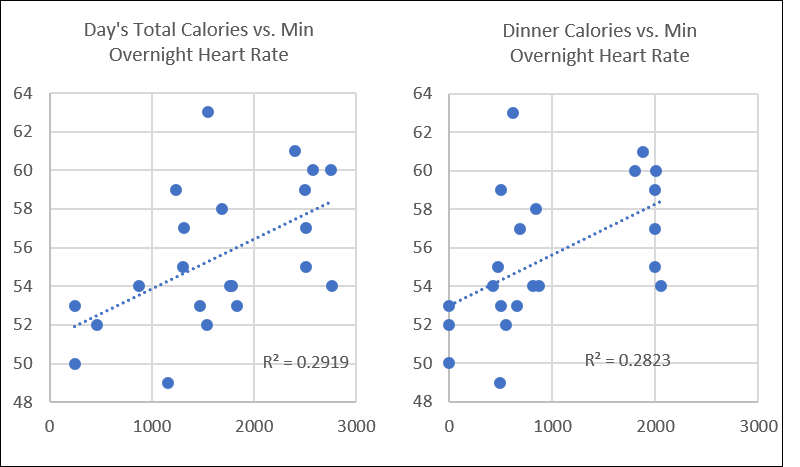 Time-restricted feeding (such as skipping dinner) lowers minimum overnight heart rate.
Time-restricted feeding (such as skipping dinner) lowers minimum overnight heart rate.
One possible explanation for the relationship between daily calories and overnight heart rate could be an indirect effect through increased awakenings overnight or increased REM sleep. (Oura notes that heart rate can rise during REM sleep.) Exploration ruled out these possible explanations. While there was a modest correlation between daily calories and minutes awake overnight (R-squared = 0.15), there was no relationship between minutes awake and overnight heart rate (R-squared = 0.01).
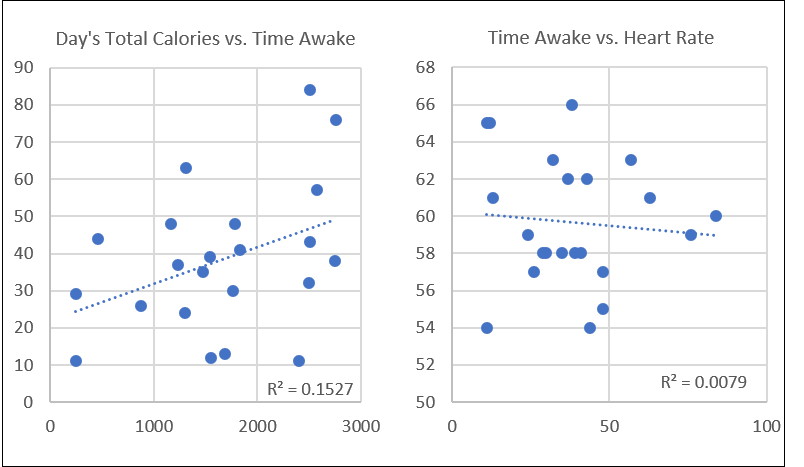 Minutes awake overnight did not explain the calories vs. overnight heart rate relationship.
Minutes awake overnight did not explain the calories vs. overnight heart rate relationship.
There was no correlation between daily calories and minutes of REM sleep (R-squared = 0.01) or between minutes of REM sleep and overnight heart rate (R-squared = 0.04).
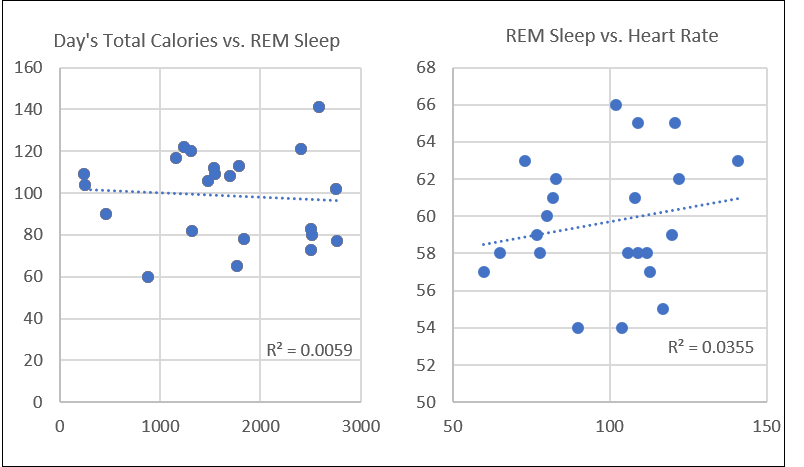 Minutes of REM sleep did not explain the calories vs. overnight heart rate relationship.
Minutes of REM sleep did not explain the calories vs. overnight heart rate relationship.
I was also curious whether heart rate variability might have a higher correlation (or inverse correlation) with daily calories than overnight heart rate. While there was a modest inverse correlation (R-squared = 0.16) between calories and heart rate variability, it was not as strong as the relationship between calories and heart rate.
Lastly, since the Oura ring also estimates respiratory rate and body temperature, I examined whether either correlated with daily calories. Both did, although the correlation was not as strong as for heart rate: calories vs. respiratory rate R-square = 0.30, calories vs. temperature R-squared = 0.18.
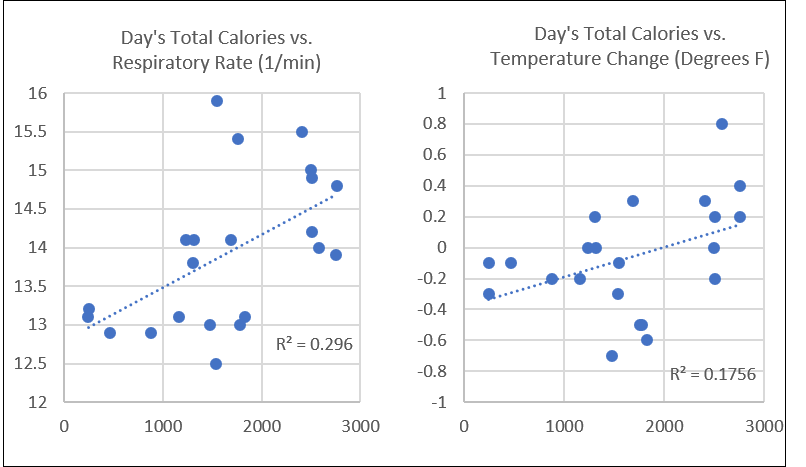 Time-restricted feeding (such as skipping dinner) lowers overnight respiratory rate and temperature.
Time-restricted feeding (such as skipping dinner) lowers overnight respiratory rate and temperature.
What can we conclude from this short experiment?
First, reduced heart rate, reduced respiratory rate and lower body temperature during sleep following reduction in daily calories is consistent with reduced metabolism observed with reduced energy intake, a likely physiological adaptation to maintain a stable body weight (adaptive thermogenesis). The flip-side may also be occurring with over-consumption increasing metabolism (higher heart rate, respiratory rate and body temperature following a large meal).
Second, this blog is based on N=1 quantified-self observations and similar results may or may not be seen in others. (Caveats include that I follow a very low carbohydrate eating pattern and am usually in ketosis so different outcomes may be seen with individuals following a high carbohydrate eating pattern. Additionally, despite my attempts to accurately track calories, I am likely under-estimating by about a third as my ~1,660 kcals daily average would not be enough for weight stability in an active 165?170 lb man.) It would be useful for others to replicate these findings and for a clinical trial of fasting or time-restricted feeding to capture overnight heart rate (along with heart rate variability, respiration and body temperature).
Third, in several searches of the medical literature, I was not able to find a prior report of reduced overnight heart rate following fasting or time-restricted feeding in humans. (Please add references to comments if you can find them ? this is too simple an observation for there not to be precedence.)
Fourth, if you use a sleep tracker, DO NOT interpret changes in your overnight heart rate as reflecting changes in cardiovascular fitness.
Fifth, if you use a sleep tracker and you vary daily calories through time-restricted feeding, fasting, or overindulging from time-to-time, DO NOT interpret changes in your overnight heart rate (and respiratory rate, body temperature and heart rate variability) as reflecting changes in ?readiness? as most sleep trackers do. More likely, these measures reflect your caloric intake that day.
Lastly, I?m now using my overnight heart rate as cross-check of my caloric consumption the prior day in addition to the inherently noisy measure of body weight. If my mean and minimum sleeping heart rates are low, I?m likely under-consuming or appropriately consuming calories to maintain weight stability. If my sleeping heart rate is high, I?m likely over-indulging and need to cut-back on my dinner.
Follow me on twitter at @JPMcCarter and let me know what you?ve learned from your sleep tracker.


